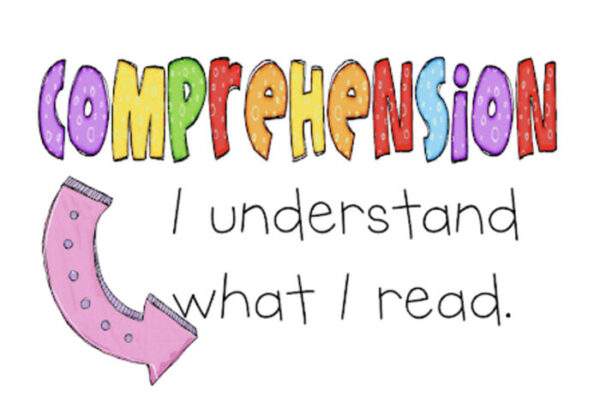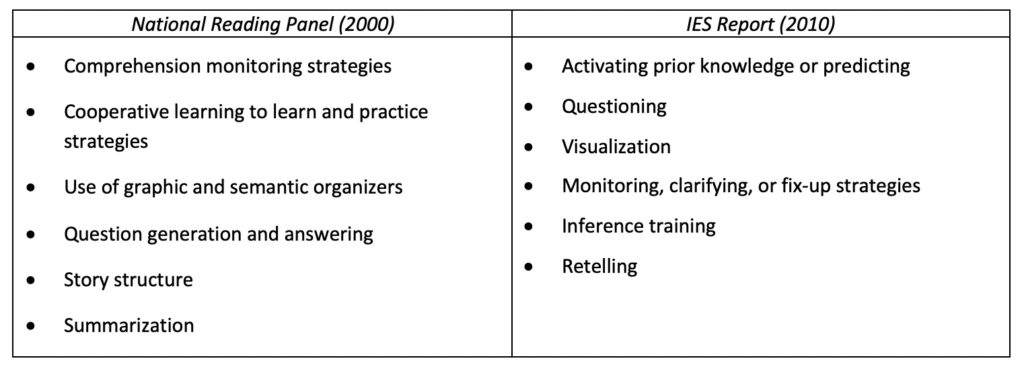Comprehension Strategy Instruction: Grades K-3

What do we know about effective instruction to support comprehension as young students in primary grades learn to read? The Institute of Education Sciences research guide titled Improving Reading Comprehension Through 3rd Grade (Shanahan et al., 2010) offers the following recommendations based on a meta-analysis of research related to comprehension instruction. This post focuses on the first — teaching comprehension strategies.
- Recommendation 1: Teach students how to use reading comprehension strategies.
- Recommendation 2: Teach students to identify and use the text’s organizational structure to comprehend, learn, and remember content.
- Recommendation 3: Guide students through focused, high-quality discussion on the meaning of text.
- Recommendation 4: Select texts purposefully to support comprehension development.
- Recommendation 5: Establish an engaging and motivating context in which to teach reading comprehension.
Recommendation 1 provides the following suggestions:
- Teach students how to use several research-based reading comprehension strategies.
- Teach reading comprehension strategies individually or in combination.
- Teach reading comprehension strategies by using a gradual release of responsibility.
The guide makes these related points (p. 10-12):
- Strategic readers use many forms of thinking and analyzing text as they read. It is therefore important to teach beginning readers strategies for constructing meaning from text.
- A strategy is the intentional application of a cognitive routine by a reader before, during, or after reading a text.
- Comprehension strategies help readers enhance their understanding, overcome difficulties in comprehending text, and compensate for weak or imperfect knowledge related to the text.
- Strategies may be taught one by one or in combination. Single-strategy instruction introduces each strategy individually and includes practice for some period of time, usually a few weeks, before the next strategy is introduced. Over time, students come to master a collection of strategies. Multiple-strategy instruction introduces several strategies simultaneously, and they are practiced in combination so that readers learn to use them together as they read.
- Teachers should use the gradual release of responsibility to eventually release responsibility for independently using strategies.
Effective Comprehension Stratagies
The report’s findings about which comprehension strategies are most effective for primary grades were similar to those identified in the National Reading Panel (2000) for all grade levels. In addition to the strategies, the panel also found that comprehension was improved when students were taught to apply more than one strategy while reading, and when strategies are taught using classroom reading material rather than taught in isolation using worksheets. View the list of strategies from both reports below.

What are strategies?
Strategies are plans or procedures that readers use and apply when they read or hear text read aloud. The strategies are intentional mental actions during reading that improve comprehension – deliberate efforts to better understand or remember.
Strategies are not:
- completing worksheets
- exercises that provide isolated practice with skills such as sequencing or drawing conclusions – these exercises lack explicit instruction, modeling, and how to think using real text.
Additional Resources for Teaching Comprehension Strategies
- Article: Key Comprehension Strategies to Teach (Reading Rockets)
- Article: Seven Strategies to Teach Students Text Comprehension (Reading Rockets)
- Video: Teaching Reading Comprehension Strategies (Institute of Education Sciences)
- Previous Literacy Lines blog posts:
References
- National Institute of Child Health and Human Development. (2000). Report of the National Reading Panel. Teaching children to read: An evidence-based assessment of the scientific research literature on reading and its implications for reading instruction (NIH Publication No. 00-4769). Washington, DC: U.S. Government Printing Office.
- Shanahan, T., Callison, K., Carriere, C., Duke, N.K., Pearson, P.D., Schatschneider, C., & Torgesen, J. (2010). Improving reading comprehension in kindergarten through 3rd grade: A practice guide (NCEE 2010-4038). Washington, DC: National Center for Education Evaluation and Regional Assistance, Institute of Education Sciences, U.S. Department of Education.

 Joan Sedita is the founder of Keys to Literacy and author of the Keys to Literacy professional development programs. She is an experienced educator, nationally recognized speaker and teacher trainer. She has worked for over 35 years in the literacy education field and has presented to thousands of teachers and related professionals at schools, colleges, clinics, and professional conferences.
Joan Sedita is the founder of Keys to Literacy and author of the Keys to Literacy professional development programs. She is an experienced educator, nationally recognized speaker and teacher trainer. She has worked for over 35 years in the literacy education field and has presented to thousands of teachers and related professionals at schools, colleges, clinics, and professional conferences.
Leave a Reply